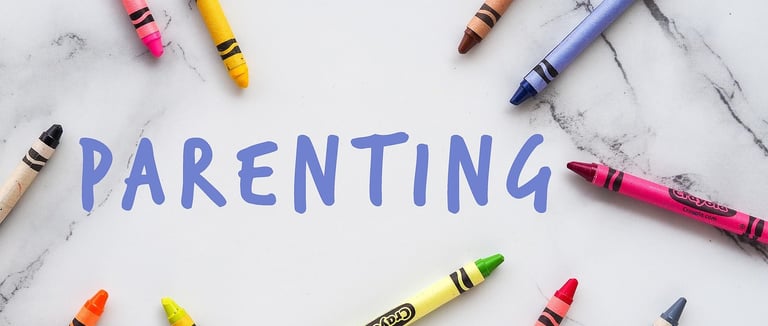How to Make Praise Work for You and Your Child
Let's talk about why and how praise can be a great tool in your parenting toolbox.
Tatyana Shchupak, Ph.D.
4/25/20254 min read


A Quick Exercise:
Think about your favorite teacher or boss. How did they respond when you succeeded—or when you made a mistake? Now think of the worst one. What did they do?
Chances are, your most respected role models gave feedback that was encouraging, specific, and helped you improve. You are your child’s teacher and guide—how do you want to respond when they do well? What about when they struggle?
Why Praise Sometimes Falls Flat
Imagine this: Your child finally cleans up their toys after dinner. You smile and say, “Good job!” But the next night? It’s back to a toy minefield. Why didn’t the praise stick? As parents, we correct our kids constantly: “No, not now.” “Don’t touch that.” “You need to listen.” These limits are necessary, but they can overwhelm the positive moments. That’s where praise comes in—not just as encouragement, but as a way to connect, build self-esteem, and guide behavior in a lasting way.
A note on misbehavior: even the best-behaved children misbehave from time to time. It's normal for well-behaved children to exhibit challenging behaviors about 20% of the time, as part of their ongoing development.
Why Praise Matters
✅ Kids crave connection—and if they can’t get it in positive ways, they’ll often seek it through negative behavior. Attention, after all, is still attention.
✅ It Reinforces Behavior—B.F. Skinner’s work on positive reinforcement teaches us that behaviors followed by praise are more likely to happen again. By increasing praise for desired behaviors, you'll naturally encourage more of them.
✅ It Builds Confidence and Connection—Research shows we need at least 5 positive interactions for every 1 negative one to maintain a healthy relationship (known as the "Gottman Ratio"). That applies to parenting too.
These interactions can be small—“I love how you handled that,” a high-five, or reading together at bedtime. Over time, they nurture a child’s sense of self-worth, fosters trust, and strengthens the emotional bond between parent and child, creating a foundation for healthy development and open communication.
Note: If praise feels awkward at first, don’t worry! Kids may raise an eyebrow (“Why are you being so weird?”), but they’ll quickly come to expect—and thrive on—it. Parents often tell me, “Now my child keeps cleaning up—and looks right at me, waiting for a reaction.” That’s the power of praise: it shifts their focus toward positive attention.
How to Use Praise Effectively
There’s a big difference between generic praise (“You’re so smart!”) and process- and effort-based praise (“You worked really hard on that puzzle!”). The former may seem encouraging, but it often places a child’s value on traits they can't control. The latter focuses on effort, strategies, and persistence—qualities they can build over time.
Praise is most powerful when it’s:
🔹 Immediate and Consistent. Catch the behavior in the moment. Don’t wait—praise works best when it’s fresh. Praise the behavior every time you see it.
🔹 Specific. Tell your child WHAT they did well. Instead of “Good job,” say: “Great job putting your books back on the shelf!”
🔹 Focuses on Effort. Praise things your child can control—like effort, problem-solving, or persistence. Example: “You kept trying even when the puzzle was hard. That shows determination!”
🔹 Uses Scaffolding. "Nice job getting all the Legos into a pile here. Looks like they're ready to go in the container. Where should we start?"
🔹 Intentional. Make it clear you mean it and it matters to you. When you say no, you often say it with intention. Let's apply the same intention (albeit positive) to saying the things you like too.
🔹 Proactive. Make it your mission to “catch them being good.” Even small efforts count.
🔹 Positive in Tone. Frame your requests positively, and praise when your child follows through. Instead of "don't put your shoes in the living room," say "put your shoes in the cabinet here" and then praise when they do.
Don't add a caveat.
✖️ “Nice job cleaning up your Legos. Why can’t you always do that?”
✔️ “Thanks for picking up your toys—everything looks so neat!”
⚠️ Watch Out: Don't accidentally praise a behavior you don’t want.
Praise in Action: Examples by Age
Toddlers: "You put your shoes away all by yourself—awesome!"
School-Aged Kids: "I saw you take a deep breath when you got frustrated. That’s using your coping skills—well done!"
Teens: "I noticed you chose to stay home and study. That shows maturity and responsibility."
Want to Learn More?
Check out these helpful parenting reads:
SOS Help for Parents by Lynn Clark, Ph.D.
Win the Whining War & Other Skirmishes by Cynthia Whitham
Explore more about the "Gottman Ratio" in different settings:
Final Thoughts
Parenting is a long game—and praise is one of your best tools. When used thoughtfully, it builds more than good behavior. It builds connection, confidence, and the kind of relationship that lasts. It’s not about being perfect. It’s about tuning in to what your child is doing well and letting them know it matters.
🧩 Praise is just one piece of the puzzle. It works best alongside clear expectations and effective consequences. Stay tuned for more posts where we’ll dive into setting limits, managing misbehavior, and raising emotionally resilient kids.
💬 Try This Today: Catch one thing your child does well—no matter how small—and give them a specific, enthusiastic compliment. See how they respond.
Disclaimer: This blog is for informational purposes only and is not a substitute for professional care. If you or your child needs support, please consult a licensed mental health professional. You’re welcome to share or reproduce this content with credit to Dr. Tatyana Shchupak and a link to tspsychological.com.
TS PSYCHOLOGICAL SERVICES, PLLC
Contact Us:
347-316-8056
© 2025. All rights reserved.
26 Court Street, Brooklyn, NY 11242
2565 E 17th St, Brooklyn, NY 11235
75-58 113 St, Forest Hills , NY 11375
Locations:
